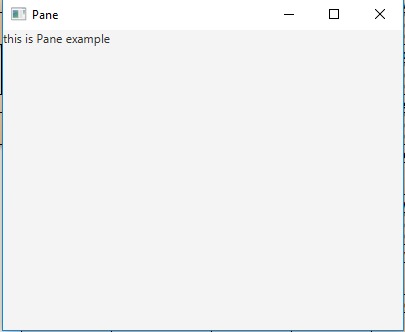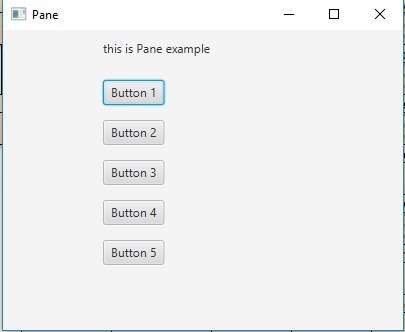窗格类是JavaFX的一部分。窗格类充当所有布局窗格的基类。本质上,它满足了将子列表公开显示的需要,以便子类的用户可以自由添加/删除子列表。窗格类继承了Region类。如果应用程序需要子代在父代中保持对齐,则必须使用StackPane。此类会调整每个受管子项的大小,无论该子项的可见属性值如何。
该类的构造函数:
- Pane():创建一个新的Pane对象。
- Pane(Node… c):使用指定的节点创建新的窗格布局。
常用方法:
| 方法 | 说明 |
|---|---|
| getChildren() | 返回窗格的子级。 |
| setLayoutX(double v) | 设置属性layoutX的值。 |
| setLayoutY(double v) | 设置属性layoutY的值。 |
| getLayoutX() | 返回属性layoutX的值。 |
| getLayoutY() | 返回属性layoutY的值。 |
| setPrefSize(double width, double height) | 设置窗格的首选大小。 |
| relocate(double x, double y) | 将对象重新定位到指定的坐标。 |
以下示例程序旨在说明Pane类的用法:
- Java程序创建一个Pane并将标签添加到Pane并将其添加到舞台:在此程序中,我们将创建一个名为Pane的窗格和一个名为label的Label。现在,通过将其作为窗格的构造函数的参数传递,将其添加到窗格中。然后将窗格添加到场景,并将场景添加到舞台。调用show()函数以显示最终结果。
// Java Program to create a Pane // and add label to the Pane // and add it to the stage import javafx.application.Application; import javafx.scene.Scene; import javafx.scene.control.*; import javafx.scene.layout.*; import javafx.stage.Stage; import javafx.event.ActionEvent; import javafx.event.EventHandler; import javafx.scene.canvas.*; import javafx.scene.web.*; import javafx.scene.layout.Pane; import javafx.scene.shape.*; public class Pane_0 extends Application { // launch the application public void start(Stage stage) { try { // set title for the stage stage.setTitle("Pane"); // create a label Label label = new Label("this is Pane example"); // create a Pane Pane pane = new Pane(label); // create a scene Scene scene = new Scene(pane, 400, 300); // set the scene stage.setScene(scene); stage.show(); } catch (Exception e) { System.out.println(e.getMessage()); } } // Main Method public static void main(String args[]) { // launch the application launch(args); } }输出:

- Java程序来创建窗格,并在窗格中添加标签和按钮,然后将它们重新放置到特定位置并将其添加到舞台:在此程序中,我们将创建一个名为Pane的窗格和一个名为label的Label。通过将此标签作为窗格的构造函数的参数传递,将其添加到窗格中。然后创建五个按钮并将它们添加到窗格中。使用relocate()函数将标签和按钮重新定位到指定位置。将窗格添加到场景并将场景添加到舞台。调用show()函数以显示最终结果。
// Java Program to create a Pane // and add labels and buttons to the pane // and relocate them to specific positions // and add it to the stage import javafx.application.Application; import javafx.scene.Scene; import javafx.scene.control.*; import javafx.scene.layout.*; import javafx.stage.Stage; import javafx.event.ActionEvent; import javafx.event.EventHandler; import javafx.scene.canvas.*; import javafx.scene.web.*; import javafx.scene.layout.Pane; import javafx.scene.shape.*; public class Pane_1 extends Application { // launch the application public void start(Stage stage) { try { // set title for the stage stage.setTitle("Pane"); // create a label Label label = new Label("this is Pane example"); // relocate label label.relocate(100, 10); // create a Pane Pane pane = new Pane(label); // add buttons for (int i = 0; i < 5; i++) { // create button Button button = new Button("Button " + (int)(i + 1)); // add button pane.getChildren().add(button); // relocate button button.relocate(100, 50 + 40 * i); } // create a scene Scene scene = new Scene(pane, 400, 300); // set the scene stage.setScene(scene); stage.show(); } catch (Exception e) { System.out.println(e.getMessage()); } } // Main Method public static void main(String args[]) { // launch the application launch(args); } }输出:

注意:以上程序可能无法在在线IDE中运行,请使用离线编译器。
参考: https://docs.oracle.com/javase/8/javafx/api/javafx/scene/layout/Pane.html
相关用法
- JavaFX 类 Tab用法及代码示例
- JavaFX 类 Pos用法及代码示例
- JavaFX 类 FileChooser用法及代码示例
- JavaFX 类 TextAlignment用法及代码示例
- JavaFX 类 FontWeight用法及代码示例
- JavaFX 类 StackPane用法及代码示例
- JavaFX 类 AnchorPane用法及代码示例
- JavaFX 类 FlowPane用法及代码示例
- JavaFX 类 Popup用法及代码示例
- JavaFX 类 LinearGradient用法及代码示例
- JavaFX 类 Stop用法及代码示例
- JavaFX 类 DirectoryChooser用法及代码示例
- JavaFX 类 Font用法及代码示例
- JavaFX 类 FontPosture用法及代码示例
注:本文由纯净天空筛选整理自andrew1234大神的英文原创作品 JavaFX | Pane Class。非经特殊声明,原始代码版权归原作者所有,本译文未经允许或授权,请勿转载或复制。
